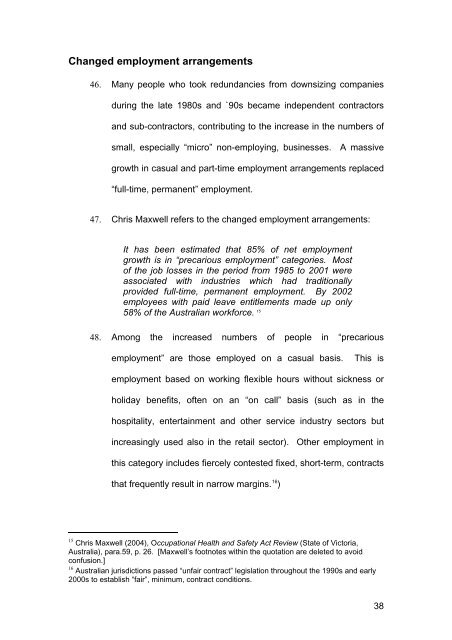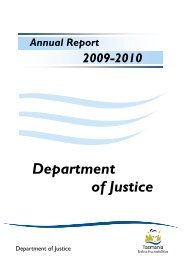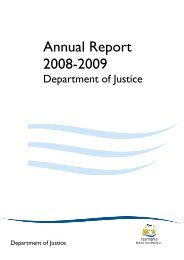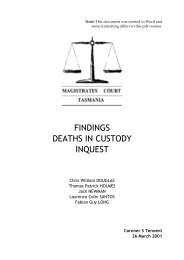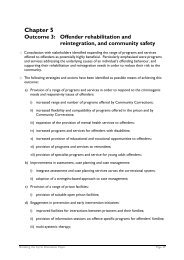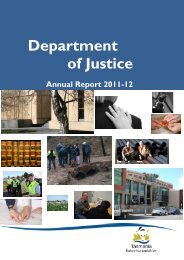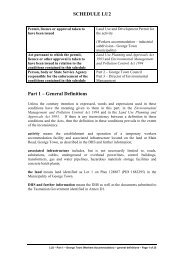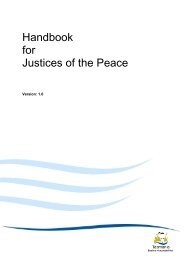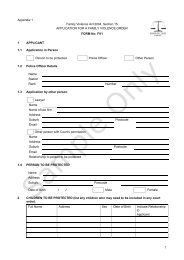- Page 1: DEPARTMENT OF JUSTICE SAFE FROM INJ
- Page 4 and 5: Apathy is the greatest single obsta
- Page 6 and 7: HMSO HSE ILO MIA MJA MSD NCDS NCSCH
- Page 8 and 9: 1. “General Duties”............
- Page 10 and 11: DIRECTOR’S POWERS AND FUNCTIONS..
- Page 12 and 13: The Robens style legislation is str
- Page 14 and 15: The report concludes with reference
- Page 16 and 17: a) to sustain a significant, contin
- Page 18 and 19: involved in focus group type meetin
- Page 20 and 21: 18. Comments and submissions may be
- Page 22 and 23: Recommendation 6: It is further rec
- Page 24 and 25: employers to provide information &c
- Page 26 and 27: could be phrased as a duty of emplo
- Page 28 and 29: Recommendation 35: It is recommende
- Page 30 and 31: CHAPTER 1 THE WORLD OF WORK 19. Our
- Page 32 and 33: quickened. 1 As a result of reforms
- Page 34 and 35: positions as well as encouraging ea
- Page 36 and 37: nineties. As individual workforces
- Page 40 and 41: 49. The Australian Bureau of Statis
- Page 42 and 43: 57. The World Health Organisation W
- Page 44 and 45: concerns as factors contributing to
- Page 46 and 47: 66. Collaboration and co-operation
- Page 48 and 49: 70. The “new breed” of enterpri
- Page 50 and 51: 76. One aspect that is different fr
- Page 52 and 53: 87. Union right of entry was establ
- Page 54 and 55: Commonwealth: Occupational Health a
- Page 56 and 57: 101. NSW introduced provisions allo
- Page 58 and 59: codes of practice; as well as recom
- Page 60 and 61: National Occupational Health and Sa
- Page 62 and 63: implementation processes associated
- Page 64 and 65: Incidence rate of compensable fatal
- Page 66 and 67: the 8 th CPM Report does not allow
- Page 68 and 69: (53.9%), followed by Fractures (10.
- Page 70 and 71: CHAPTER 3 WORKPLACE HEALTH AND SAFE
- Page 72 and 73: the inspectorates experience diffic
- Page 74 and 75: more involvement of workpeople them
- Page 76 and 77: usiness that needs to be managed ro
- Page 78 and 79: that if employees are to participat
- Page 80 and 81: care” in fulfilment of the genera
- Page 82 and 83: Preventing major accidents 185. Saf
- Page 84 and 85: oth industry in implementing the du
- Page 86 and 87: 199. The discussion of frameworks c
- Page 88 and 89:
employers, concluding that national
- Page 90 and 91:
213. It is also worth considering h
- Page 92 and 93:
218. The Office of the ASCC, althou
- Page 94 and 95:
October 2006 on Harmonisation of Wo
- Page 96 and 97:
230. It is not clear whether non-st
- Page 98 and 99:
238. The question now confronting r
- Page 100 and 101:
there are hundreds of pages of pote
- Page 102 and 103:
CHAPTER 3 ACCOUNTING FOR CHANGES To
- Page 104 and 105:
safety in dealing with dangerous go
- Page 106 and 107:
263. Acts for workplace health and
- Page 108 and 109:
illness or death is sufficiently cl
- Page 110 and 111:
‘Self-regulatory’ or ‘Prescri
- Page 112 and 113:
public interest regulatory requirem
- Page 114 and 115:
• With different health and safet
- Page 116 and 117:
eferred the review team to the COAG
- Page 118 and 119:
295. Nevertheless, further reductio
- Page 120 and 121:
the message of the legislation is c
- Page 122 and 123:
303. A close relationship between t
- Page 124 and 125:
eported in 1998) rather than as an
- Page 126 and 127:
to “ensure compliance with legisl
- Page 128 and 129:
that are features of the NSW and Qu
- Page 130 and 131:
This small beginning is commended,
- Page 132 and 133:
334. This is sound advice and appli
- Page 134 and 135:
343. It is emphasised that the prop
- Page 136 and 137:
352. In the establishment and gover
- Page 138 and 139:
sections 5, 6 and 7 of the Act in r
- Page 140 and 141:
all jurisdictions now we believe),
- Page 142 and 143:
makes enterprises more productive.
- Page 144 and 145:
take reasonable care for the employ
- Page 146 and 147:
providers”; “persons in control
- Page 148 and 149:
395. Statutory prevention duties pr
- Page 150 and 151:
402. In the investigation of accide
- Page 152 and 153:
Social responsibility and sharehold
- Page 154 and 155:
persons who exercise management aut
- Page 156 and 157:
finding that 88% of accidents arise
- Page 158 and 159:
the duty holder and the contractor,
- Page 160 and 161:
extent of the duty is not subject t
- Page 162 and 163:
On-hired services (on-hired employe
- Page 164 and 165:
444. In practice however, such co-o
- Page 166 and 167:
Any employer who exercises, or is i
- Page 168 and 169:
461. Maxwell articulates this subje
- Page 170 and 171:
education or training institution a
- Page 172 and 173:
The amendment needs to be drafted s
- Page 174 and 175:
“speaks” in this provision, the
- Page 176 and 177:
employees, but only if the Director
- Page 178 and 179:
Recommendation 12: It is recommende
- Page 180 and 181:
Information, instruction, training
- Page 182 and 183:
Presentation of the general duties
- Page 184 and 185:
or engaged by a contractor, is not
- Page 186 and 187:
Obligations set out by the Regulati
- Page 188 and 189:
524. The analysis of section 9 iden
- Page 190 and 191:
Changing work environment, changing
- Page 192 and 193:
What respondents said 534. In the c
- Page 194 and 195:
541. This chapter looks at some of
- Page 196 and 197:
assaults resulting in injuries or l
- Page 198 and 199:
health may be dealt with early and
- Page 200 and 201:
access to technology which keeps wo
- Page 202 and 203:
568. Health services workers, nursi
- Page 204 and 205:
• Social and organisational aspec
- Page 206 and 207:
Legislative obligations to identify
- Page 208 and 209:
as the most common cause of severe
- Page 210 and 211:
Systematic processes 589. The huge
- Page 212 and 213:
might have seemed to be a straightf
- Page 214 and 215:
the hazard cannot be eliminated (re
- Page 216 and 217:
nature of terms such as ‘hazard
- Page 218 and 219:
ergonomists and engineers have pred
- Page 220 and 221:
where management control is transla
- Page 222 and 223:
The recommended workplace health an
- Page 224 and 225:
631. Robens therefore recommended t
- Page 226 and 227:
their duties. Communication is basi
- Page 228 and 229:
Legislation and consultation 645. P
- Page 230 and 231:
decision. The decision remains that
- Page 232 and 233:
and safety are agreed and documente
- Page 234 and 235:
• Mental disorders. 156 665. The
- Page 236 and 237:
669. However there are some doubts
- Page 238 and 239:
action area of the National Health
- Page 240 and 241:
mental disorders. How can the legis
- Page 242 and 243:
692. We can expect that there will
- Page 244 and 245:
mental disorders, we need to streng
- Page 246 and 247:
negotiation between workers and man
- Page 248 and 249:
health and safety issues that have
- Page 250 and 251:
Employers, principals, contractors,
- Page 252 and 253:
approach of the legislation would h
- Page 254 and 255:
Inspectorate 724. The Act confers p
- Page 256 and 257:
giving the answer or providing the
- Page 258 and 259:
Legislated powers to give advice, e
- Page 260 and 261:
747. The percentage of proactive in
- Page 262 and 263:
754. (See the diagram below - with
- Page 264 and 265:
disease at workplaces and the devel
- Page 266 and 267:
Small business support 762. The maj
- Page 268 and 269:
769. We see value in developing pro
- Page 270 and 271:
highlights the importance of traini
- Page 272 and 273:
Resources 782. In consideration of
- Page 274 and 275:
employees in their employment with
- Page 276 and 277:
796. The Construction Forestry Mini
- Page 278 and 279:
802. The CBB submission proposes th
- Page 280 and 281:
• That penalties should be awarde
- Page 282 and 283:
Tasmania’s penalties for an indiv
- Page 284 and 285:
safety framework) would seem to mak
- Page 286 and 287:
Industry codes of practice 830. The
- Page 288 and 289:
838. Section 4 of the Act binds the
- Page 290 and 291:
Designated Workplaces 845. The Act
- Page 292 and 293:
Barbara Elliot Chris Hinds Leanne W
- Page 294 and 295:
Release. Retrieved from DEWR websit
- Page 296 and 297:
Australian Government 6 April 2006,
- Page 298 and 299:
Bertram, J. 2006, Heads of Workplac
- Page 300 and 301:
Centre for Applied Social Research
- Page 302 and 303:
Davis, Courtney n.d. Making Compani
- Page 304 and 305:
Ford, Sean 2005, ‘Guilty Plea To
- Page 306 and 307:
Hall, A., Johnstone, R. & Ridgeway
- Page 308 and 309:
House of Commons Hansard Debate 200
- Page 310 and 311:
Joy, Jim & Griffiths, Derek 2005, N
- Page 312 and 313:
Makin, A.M. & Winder, C. 2006, OHS
- Page 314 and 315:
Nielsen, E. 2004, Regulation, Co-re
- Page 316 and 317:
Regulation Task Force 2006, Rethink
- Page 318 and 319:
Taylor, Chris 2006, ‘High Court D
- Page 320 and 321:
WorkSafe Victoria 2004, Summary of


